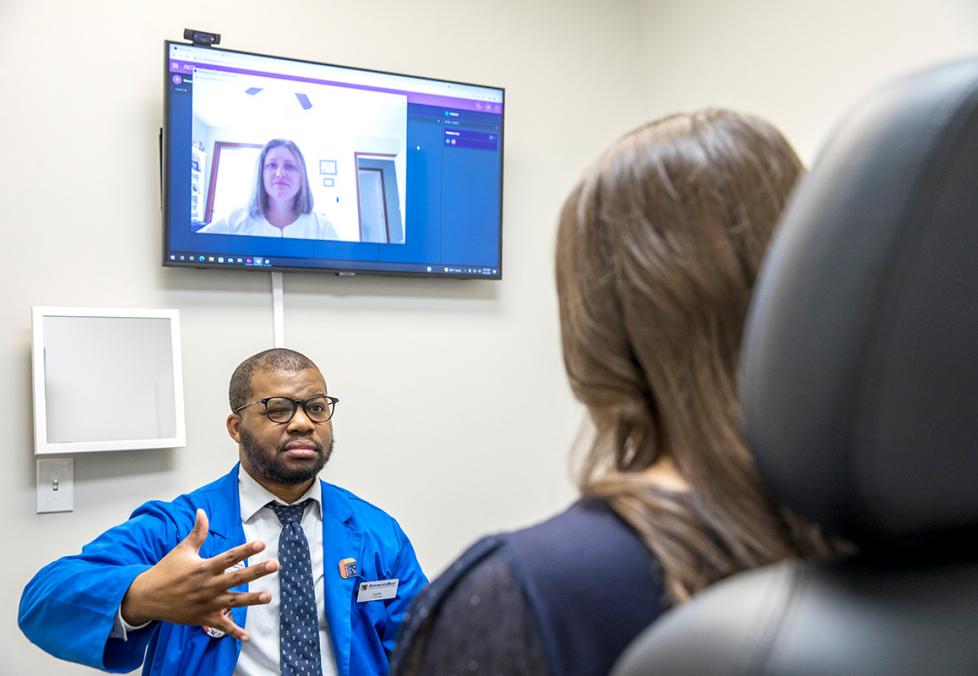
America’s Best is expanding access to vision care through our new partially remote eye exams. Learn more about how it works and if it’s right for you.

Did you know that an optometrist who practices in Arizona can examine the eyes of someone in New York City — or write a new eyeglasses prescription for a person who lives in Minnesota? Thanks to the new digital eye exam option at America’s Best Contacts & Eyeglasses, it’s possible.
So, how does it work? It’s a telehealth exam where a patient comes into their nearest America’s Best store and has an on-screen appointment with a doctor located elsewhere who can perform an examination, says Priti Patel, O.D. She is the senior vice president of health care strategy and development at National Vision Inc., the parent company of America’s Best Contacts & Eyeglasses. The program has been rolled out to more than 400 America’s Best stores so far.
With the assistance of an on-site technician, an eye doctor from anywhere in the country can perform your eye exam. “The doctor could live in Los Angeles and still remotely dial into a rural town in any state,” says Dr. Patel.
This type of hybrid-remote exam has expanded the number of appointments available each day for our customers, making it easier for them to find a time that works with their schedule. Find out more about digital eye exams to decide if you want to try it.
Has it been a while since your last eye exam? Now’s the time to book an appointment!
How is a digital eye exam different from an in-person exam?
The main way they differ is that you’re not in the same room as your eye doctor. But it’s the similarities between these two types of visits that matter most.
“From a quality perspective, it’s compatible to a traditional eye exam,” says Dr. Patel. A digital eye exam at America’s Best also costs the same as a regular in-person exam.
Both types of exams begin with what is called a pretest. That’s when an optometric technician performs a short series of checks to test your eye pressure, measure the shape and size of your cornea, and assess your visual acuity by reading the eye chart.
Press play to learn more about what happens during the pretest portion of your eye exam:
The pretest results are sent to your remote optometrist to review in real time. Then you’ll begin your remote eye exam with your optometrist. You’ll see each other on a large screen in the exam room. You can discuss any questions that you have, just as if the eye doctor were physically in the room with you.
With the technician’s help, your optometrist will perform additional vision and eye health tests, including checking your eye movement, alignment, and pupil function. It’s what Dr. Patel calls a synchronous eye exam.
“The doctor is on screen the whole time, and the technician acts as the eyes and the hands of the doctor,” she says. “The doctor is able to view it in live time.”
Once your optometrist has completed the exam, they’ll work with the technician to determine your prescription and put together a care plan for you.
What are the benefits of a digital eye exam?
The main advantage is that it expands access to eye-health care, says Dr. Patel. “Some patients have to drive far to get an appointment at a time that works. Now, we’re able to open up more times that they will be able to see a doctor.”
This is especially true for patients who live in rural areas, where there may not be as many optometrists, says Dr. Patel.

Who is a good candidate for a digital eye exam?
Because a digital eye exam is comprehensive, it’s a great choice for most people who need a routine eye exam or an updated prescription, says Dr. Patel. People who should try this include:
- Adults and children with relatively healthy eyes. As long as you don’t have any serious eye diseases or issues, a digital eye exam should serve you well. Older kids are also great candidates for this style of remote eye exam, says Dr. Patel.
- Eyeglasses wearers. If the only purpose of your visit is that you need a new pair of frames, the in-store technician and the optometrist can collaborate to update your prescription and measure your eyes to fit you for eyeglasses.
- Contact lens wearers who like the brand they already use. Longtime contact lens wearers already know how to insert and remove their contacts correctly. So, if you’re satisfied with the fit and performance of what you’re already using, a digital eye exam is a convenient way to get your prescription updated.
Who is not a good candidate for a digital eye exam?
Some patients may need more specialized care than others. There are a few scenarios in which an in-person exam may be needed:
- First-time contact lens wearers. Learning how to properly insert and remove contact lenses is key to wearing them safely and effectively. But it’s a little tricky to learn how to do that, so Dr. Patel thinks new wearers are better suited to an in-person exam. When you choose contact lenses, you also need a follow-up exam where your optometrist will check the fit of the lens on your eye. The technology isn’t quite good enough yet to replace that visit, says Dr. Patel.
- People with certain eye diseases. If you already have a diagnosis of a serious eye disease such as cataracts or diabetic retinopathy, digital eye exams aren’t for you. Also, if you’ve injured your eye, you’ll need to come in and see a doctor in person. It’s safer to monitor these patients in person, says Dr. Patel.
How do I schedule a digital eye exam at America’s Best?
It’s easy. You do it the same way you’d schedule any other kind of exam at America’s Best: online or over the phone with a store associate. When you’re scheduling your appointment online, some dates and times will show up as “Digital Eye Exams” available.
The booking system should make it clear that you’ve scheduled the correct type of visit, and you will be sent a confirmation notice with the details. “Our teams work to find the best time, day, and type of exam the patient is looking for,” says Dr. Patel.

